| Chapter 2: Deposits
Endorsing a check
Even in this electronic age, the check is still the payment method used by many employers (and doting grandparents!). In order to deposit or cash a check, you first need to endorse it. There are three basic types of endorsements:
- Blank endorsement: A blank endorsement is made by signing your name on the back of the check. You must sign it exactly the way it appears on the “Pay to the Order of” line. Anyone can cash or deposit a check with a blank endorsement, even if the check is not written to him or her. You should only do a blank endorsement if you are cashing a check, and don’t sign it until you are at the financial institution.
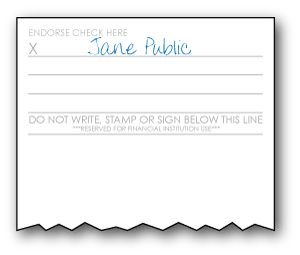
- Restrictive endorsement: A restrictive endorsement is made by writing “For deposit only” on the first line of the back of the check and then signing your name underneath. A check with a restrictive endorsement can only be deposited into an account in your name. Some financial institutions also prefer that you write your account number on the check to make it easier to process. However, others see this as a security risk, and ask you not to write your account number on the check.
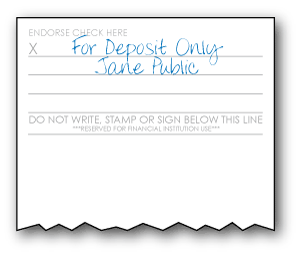 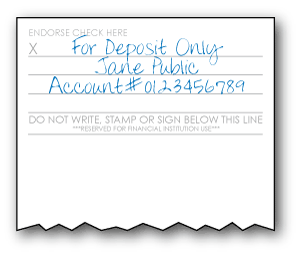
- Special endorsement: A check is signed with a special endorsement when you want to give your check to another person. It is different from a blank endorsement in that the check can only be cashed or deposited by the person you are assigning the check to. To do a special endorsement, write “Pay to the order of [name of person you are giving check to]”, and sign your name underneath.
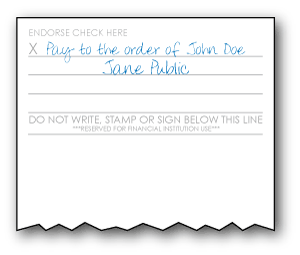
Depositing checks and cash
In order to deposit a check or cash, you must go to the financial institution and see a teller or use an ATM.
To make a deposit with a teller, you need to fill out a deposit slip. You may have deposit slips in your checkbook that already have your account number printed on it. When you are filling out the amount(s) you are depositing, remember to write in the correct section – generally, there are different sections for currency (paper cash), coin, and check deposits. List each check separately, and use the back side if needed. If you want to receive some cash back from a check you are depositing, you should write that amount in the “Less Cash Received” section. (You may not need to fill out a deposit slip if you are cashing the full amount of a check.)
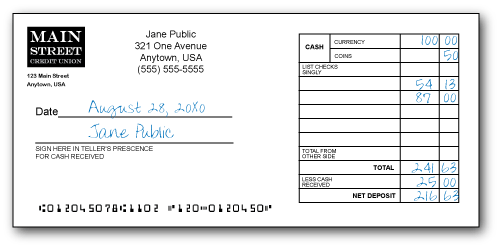
If you are using an ATM, first read the instructions for making a deposit. All ATMs require you to insert your debit or ATM card and enter your pin number, but while some ask you to fill out a deposit slip and insert the slip and deposit into the machine in an envelope, others allow you to directly insert checks or cash into the machine without an envelope or deposit slip. Remember to save your receipt, and when you receive your statement or check your account activity on-line, verify that your balance was properly credited.
When you deposit a check, it is common for all or part of the funds to be placed on hold (unavailable for withdrawal) while the check is being processed. Even if you cash a check, a hold will often be placed on an equivalent amount of money in your account. Once the money is deducted from the check writer’s account, the hold is lifted. Processing time varies, but it is usually no more than a few business days. However, if the amount of the check is greater than the funds in the check writer’s account, the check may bounce. If this happens, you will not get the money from the check. In addition, your financial institution may charge you a fee. If someone gives you a check that later bounces, you should immediately contact that person and give him or her the opportunity to correct the situation – this can include paying you the amount of the bad check (you may want to insist on payment in cash) as well as any fees you are assessed.
Direct deposit
Direct deposit is a deposit method in which money is electronically transferred into your account without the issuance of a paper check. This method is frequently used for employee paychecks and government benefits, such as Social Security and unemployment insurance. If your employer offers direct deposit, you may want to take advantage of it. Direct deposit is convenient – you don’t have to be constantly running to the bank or credit union to deposit your paychecks. You also do not have to worry about your checks getting lost or stolen. Furthermore, direct deposits are often processed quicker than paper checks, giving you access to the money sooner.
To enroll in direct deposit, ask your employer for a sign-up form. In addition to providing your account information on the form, you may also need to supply a voided check. To void a check, simply write the word “VOID” across it. Once the direct deposit is set up, you should monitor your account to make sure that the money is being properly deposited. If there are any problems, notify your employer immediately. |





